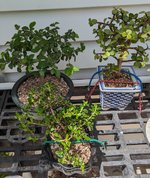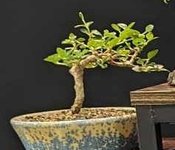SharonP
Seedling
Substrate question with a LOT of background:
I started in bonsai 16 months ago (after decades in other horticultural hobbies) and have over a dozen species of Shohin-sized tropicals. I live in Wisconsin, USA (zone 5). Some trees live indoors under good SpiderFarmer lights year-round, others go outside in summer. They all get RO water, liquid and organic/pelleted fertilizer and occasional worm tea.
Unlike all my other plants (garden, indoor houseplants, etc.), my bonsai trees have EXTREMELY slow growth, whether indoors or out. They no obvious signs of poor health (no yellow or brown leaves, root rot, insect damage, etc.), but many can go months without putting out a pair of new leaves. For instance, other local bonsai club members’ Portulacaria trees grow >10 cm in height a week when outside. My 2 year old Portulacaria (also outside summers) is the same small height as when I got it a year ago. I don’t think it’s grown more than a couple of new leaves in the year I’ve had it.
Other club members are mystified why my trees don’t grow, whether indoors or out. I water with RO water and use liquid bonsai fertilizer with nearly every watering (daily outdoors, every 2 days indoors). I also use a microbiome supplement similar to worm tea. When outside in summer, the trees also get high-quality organic pelleted bonsai fertilizer. The only thing I could think of was the Bonide systemic insecticide I use every 2 months is stunting them. However, I use this on my tropical houseplants, too, and those all show very vigorous and luxurious growth.
Then I started looking at the substrate. The difference between my happy tropical houseplants and the unhappy tropical bonsai is that the bonsai are in 100% akadama/pumice/lava rock.
When I buy my (usually 3-5 year old) trees from growers in the southern U.S., they arrive in bonsai pots in 100% potting soil. They are healthy and happy. But per instructions from the 25+ bonsai books I've read and a class on repotting bonsai, I immediately remove ALL the soil and repot the tree in akadama/pumice/lava rock. (To avoid the dreaded "root rot"!) Fellow local bonsai club members will drive hours to buy this mix when they run out. So I just assumed every bonsai tree in the world wants to go in that mix, but that commercial growers simply can’t afford the stuff.
Now I’m wondering if my trees are in a sort of stasis; desperate to return to potting soil where they can thrive once again. Maybe a gravely akadama mix that's great for a 50 year old pine bonsai is not ideal for a 3 year old tropical. And especially a Shohin that’s in like 2 cups of substrate to start with.
To fellow tropical bonsai enthusiasts: I'm planning to repot all my trees ASAP (I think it's okay to repot tropicals year-round). What substrate do you recommend? 100% potting soil? Mixes involving coco coco coir, sphagnum, or akadama? I don’t want another summer to go to waste with my trees in this state where they’re alive but not growing. Thanks!
(Photo taken just a minute ago shows three of my very slow-growing trees: Serissa, Portulacaria, Chinese elm)
I started in bonsai 16 months ago (after decades in other horticultural hobbies) and have over a dozen species of Shohin-sized tropicals. I live in Wisconsin, USA (zone 5). Some trees live indoors under good SpiderFarmer lights year-round, others go outside in summer. They all get RO water, liquid and organic/pelleted fertilizer and occasional worm tea.
Unlike all my other plants (garden, indoor houseplants, etc.), my bonsai trees have EXTREMELY slow growth, whether indoors or out. They no obvious signs of poor health (no yellow or brown leaves, root rot, insect damage, etc.), but many can go months without putting out a pair of new leaves. For instance, other local bonsai club members’ Portulacaria trees grow >10 cm in height a week when outside. My 2 year old Portulacaria (also outside summers) is the same small height as when I got it a year ago. I don’t think it’s grown more than a couple of new leaves in the year I’ve had it.
Other club members are mystified why my trees don’t grow, whether indoors or out. I water with RO water and use liquid bonsai fertilizer with nearly every watering (daily outdoors, every 2 days indoors). I also use a microbiome supplement similar to worm tea. When outside in summer, the trees also get high-quality organic pelleted bonsai fertilizer. The only thing I could think of was the Bonide systemic insecticide I use every 2 months is stunting them. However, I use this on my tropical houseplants, too, and those all show very vigorous and luxurious growth.
Then I started looking at the substrate. The difference between my happy tropical houseplants and the unhappy tropical bonsai is that the bonsai are in 100% akadama/pumice/lava rock.
When I buy my (usually 3-5 year old) trees from growers in the southern U.S., they arrive in bonsai pots in 100% potting soil. They are healthy and happy. But per instructions from the 25+ bonsai books I've read and a class on repotting bonsai, I immediately remove ALL the soil and repot the tree in akadama/pumice/lava rock. (To avoid the dreaded "root rot"!) Fellow local bonsai club members will drive hours to buy this mix when they run out. So I just assumed every bonsai tree in the world wants to go in that mix, but that commercial growers simply can’t afford the stuff.
Now I’m wondering if my trees are in a sort of stasis; desperate to return to potting soil where they can thrive once again. Maybe a gravely akadama mix that's great for a 50 year old pine bonsai is not ideal for a 3 year old tropical. And especially a Shohin that’s in like 2 cups of substrate to start with.
To fellow tropical bonsai enthusiasts: I'm planning to repot all my trees ASAP (I think it's okay to repot tropicals year-round). What substrate do you recommend? 100% potting soil? Mixes involving coco coco coir, sphagnum, or akadama? I don’t want another summer to go to waste with my trees in this state where they’re alive but not growing. Thanks!
(Photo taken just a minute ago shows three of my very slow-growing trees: Serissa, Portulacaria, Chinese elm)





